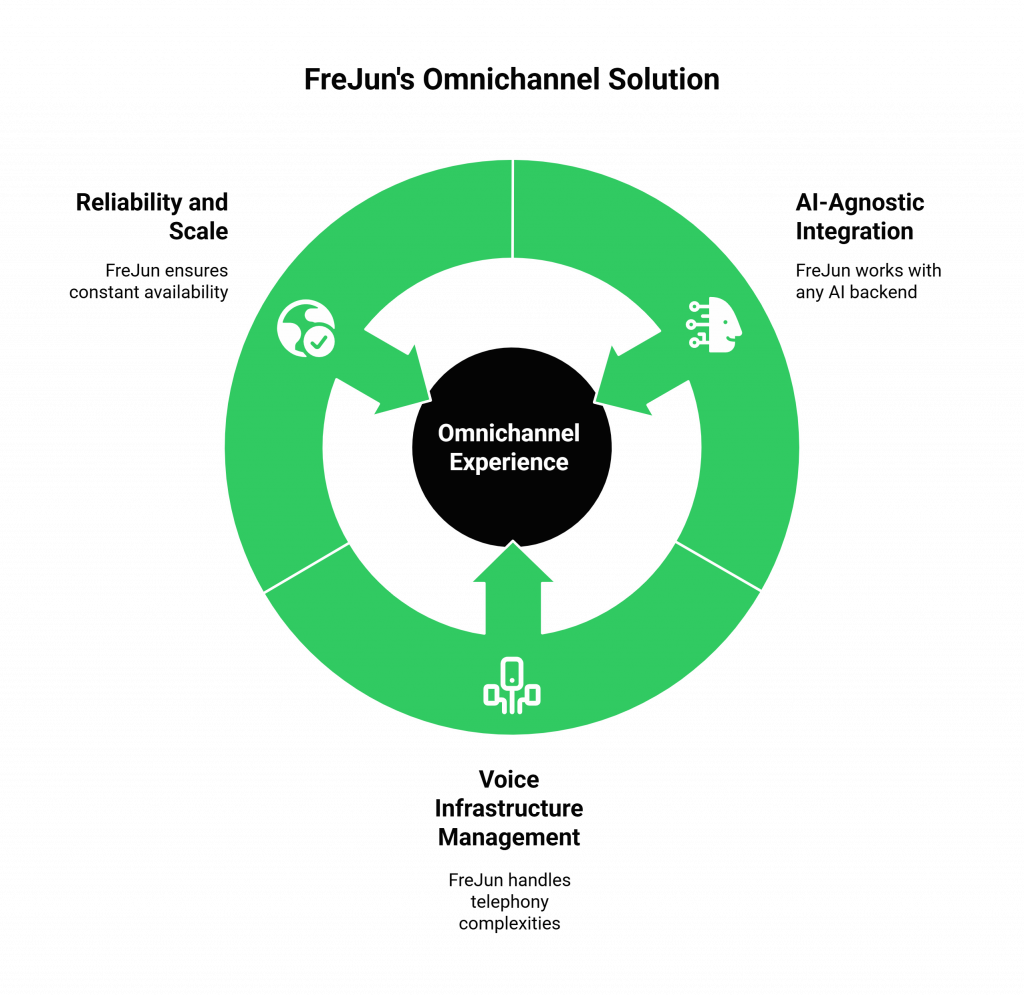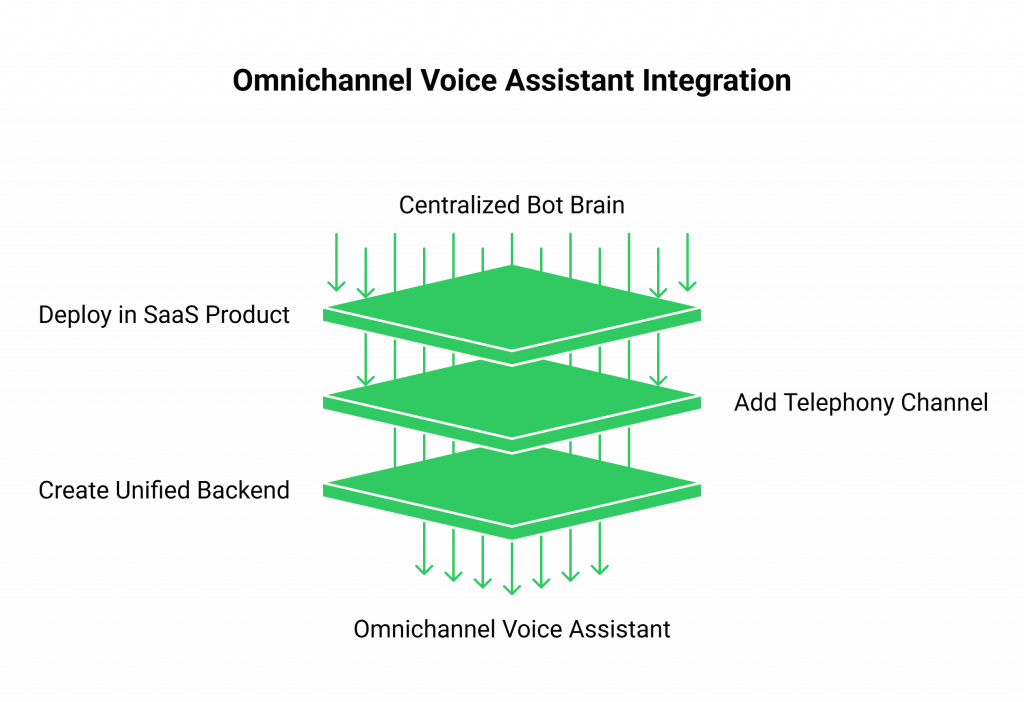The way users interact with software is undergoing a seismic shift. The traditional graphical user interface, while effective, is no longer the only way. Forward-thinking SaaS platforms are now integrating a Voice Assistant Chatbot to offer a faster, more natural, and more accessible way for users to get support, automate tasks, and navigate complex workflows. This isn’t just a trend; it’s the next evolution of the user experience, promising 24/7 service, enhanced efficiency, and deeper user engagement.
Table of contents
- What is a Voice Assistant Chatbot for SaaS?
- The Integration Trap: Why Your SaaS Bot is Incomplete
- FreJun: The API That Makes Your Bot Truly Omnichannel
- In-App Voice Assistant vs. Omnichannel Voice Assistant (with FreJun)
- How to Integrate a True Omnichannel Voice Assistant Chatbot ?
- Best Practices for a Flawless SaaS Integration
- Final Thoughts: From a Smart Feature to a Strategic Asset
- Frequently Asked Questions (FAQ)
With a rich ecosystem of AI platforms and APIs, the technical path to building an in-app voice assistant has never been clearer. However, a critical and costly blind spot exists in many integration strategies. A brilliant bot that lives only within your digital walls is an incomplete solution, unable to serve your customers on the one channel that often matters most for high-stakes interactions.
What is a Voice Assistant Chatbot for SaaS?
A Voice Assistant Chatbot for SaaS is a sophisticated conversational agent that integrates directly with your platform to help users via spoken commands. It’s a 24/7, AI-powered employee that understands your product and your users. The core technology involves a real-time pipeline:
- Automatic Speech Recognition (ASR): Transcribes a user’s spoken words into text.
- Natural Language Processing (NLP/LLM): The AI “brain” that understands the user’s intent, manages the dialogue, and formulates a response.
- SaaS Integration: The bot connects to your platform’s backend APIs and third-party tools (like CRMs and helpdesks) to execute tasks and provide personalized information.
- Text-to-Speech (TTS): Synthesizes the AI’s text response back into a lifelike, audible voice.
When implemented correctly, this bot can dramatically boost operational efficiency and create a superior user experience.
The Integration Trap: Why Your SaaS Bot is Incomplete
Modern AI platforms like Voiceflow, Rasa, and Microsoft’s Bot Service have made it incredibly easy to build the “brain” of a Voice Assistant Chatbot and deploy it within a web or mobile application. The in-app experience can be seamless and powerful.
But what happens when your highest-value enterprise client has a critical, time-sensitive issue and their first instinct is not to log into your portal, but to call your support hotline? What about a sales lead who wants to speak to someone immediately after seeing a demo?
At this moment, your brilliant in-app assistant is completely unreachable. This is the integration trap. The very platforms and protocols that excel at handling voice within a browser are not designed to interface with the Public Switched Telephone Network (PSTN). To make your bot answer a phone call, you would have to build a highly specialized and complex telephony infrastructure from scratch, a task that is both a massive technical distraction and a significant financial investment.
FreJun: The API That Makes Your Bot Truly Omnichannel
This is the exact problem FreJun was built to solve. We are not another AI platform. We are the specialized voice infrastructure layer that connects the intelligent Voice Assistant Chatbot you’ve already built to the global telephone network.

FreJun provides a simple, developer-first API that handles all the complexities of telephony, allowing you to create a truly seamless, omnichannel experience for your SaaS users.
- We are AI-Agnostic: You bring your own bot’s “brain.” FreJun integrates with any backend, whether it’s powered by Voiceflow, Rasa, or a custom stack of APIs.
- We Manage the Voice Infrastructure: We handle the phone numbers, the SIP trunks, the real-time media servers, and the low-latency audio streaming.
- We Guarantee Reliability and Scale: Our globally distributed, enterprise-grade platform ensures your phone line is always online and ready to handle high call volumes, just like your SaaS product.
With FreJun, you can finally break your assistant out of its digital cage and deploy it as a powerful front-line agent for your entire business.
In-App Voice Assistant vs. Omnichannel Voice Assistant (with FreJun)
| Capability | The In-App Voice Assistant Bot | The Omnichannel Voice Assistant Bot (with FreJun) |
| Accessibility | Limited to logged-in users who are actively using your SaaS tool. | Universally accessible to any customer with a phone, plus all digital channels. |
| Primary Use Cases | In-app onboarding, feature guidance, voice-driven navigation. | 24/7 call centers, automated sales qualification, critical incident support. |
| Business Impact | A modern UX feature that improves digital engagement and reduces friction. | A strategic asset that dramatically reduces operational costs. |
| Infrastructure Burden | Low. Managed by the AI platform’s SDKs and widgets. | Zero telephony infrastructure to build. FreJun manages the entire voice stack. |
| Customer Journey | Fragmented. A user may have to switch from a call to your web app. | Unified. A user can interact with the same intelligent assistant across all channels. |
How to Integrate a True Omnichannel Voice Assistant Chatbot?
This step-by-step guide outlines the modern architecture for creating a voice assistant that works both inside your SaaS product and over the phone.

Step 1: Build Your Bot’s Centralized “Brain”
First, use your chosen AI platform (like Voiceflow or Rasa) to design the core conversational logic. This “brain” will handle intent recognition, dialogue management, and integration with your SaaS backend and third-party tools (CRM, helpdesk, etc.). This is the heart of your Voice Assistant Chatbot.
Step 2: Deploy the Bot Inside Your SaaS Product
Use the platform’s built-in tools (like a web widget or an SDK) to embed the voice assistant directly into your web and mobile applications. This will handle the in-app voice experience.
Step 3: Add the Telephony Channel with FreJun’s API
This is the critical step that makes your bot truly omnichannel.
- Sign up for FreJun and instantly provision a virtual phone number.
- Use FreJun’s server-side SDK in your backend to handle incoming WebSocket connections from our platform.
- In the FreJun dashboard, configure your new number’s webhook to point to your backend’s API endpoint.
Step 4: Create a Unified Backend to Route Requests
Your backend application will now act as a central hub.
- When a request comes from your web/mobile app, it will likely be text. Your backend passes this directly to your bot’s “brain.”
- When a call comes in via FreJun, your backend receives the raw audio stream. It then orchestrates the calls to your chosen STT and TTS APIs, using your bot’s “brain” for the logic in between.
This unified backend ensures the same intelligent core is powering every conversation, regardless of the channel.
Pro Tip: Design for API-Based Extensibility
When implementing your Voice Assistant Chatbot, build its core logic to be modular and extensible via APIs. The bot’s ability to perform actions (like creating a support ticket or updating a CRM record) should be handled through well-defined internal APIs. This approach not only makes it easier to add new workflows in the future but also ensures that the same core actions can be triggered by a user in your app or a user calling in via FreJun, creating a truly unified system.
Best Practices for a Flawless SaaS Integration
- Prioritize Security and Compliance: Handle all user data, especially voice recordings and sensitive information from your SaaS tools, with strict security measures and in compliance with regulations like GDPR.
- Optimize for Low Latency: A natural conversation requires speed. Use real-time streaming ASR and TTS APIs to ensure a fluid, human-like interaction.
- Design for a Seamless Human Handoff: No AI is perfect. For complex or sensitive issues, design a clear process to escalate the conversation from your bot to a live human agent, ensuring the full context is transferred with the call.
- Support Multi-Language and Accents: To maximize accessibility for a global user base, choose ASR and TTS services that provide robust support for different languages and dialects.
- Continuously Monitor and Improve: Use a unified analytics dashboard to track bot performance, resolution rates, and user satisfaction across your web app, mobile app, and phone line.
Final Thoughts: From a Smart Feature to a Strategic Asset
Your SaaS product is designed to solve complex problems and make your users’ lives easier. Implementing a Voice Assistant Chatbot is the next logical step in that mission. But to unlock its true potential, that assistant must be available everywhere your users are.
By extending your bot’s reach to the telephone network, you transform it from a helpful in-app feature into a powerful, 24/7 business asset. It can scale your support, accelerate your sales cycle, and deliver a level of service that sets you apart from the competition.
The path to this transformation doesn’t require you to become a telecom company. It requires a smart integration strategy. Focus on building the best AI brain with a leading conversational platform, and partner with FreJun to give that brain a powerful, reliable voice that can be heard across every channel.
Further Reading – How to Build AI Voice Agents Using Amazon Alexa LLM?
Frequently Asked Questions (FAQ)
No, it complements them. You use those platforms to build the AI “brain” and manage the digital channels. FreJun provides the separate, essential infrastructure to connect that same brain to the telephone network.
Yes, and this is the recommended approach. A unified backend that houses your core AI logic ensures a consistent experience and is far more efficient to maintain.
Yes. FreJun provide enterprise-grade security by design. We support encryption and are designed to help you comply with major data protection regulations.
Absolutely. FreJun’s API provides full call control, including the ability to programmatically initiate outbound calls. This allows your bot to be used for proactive tasks like onboarding follow-ups, renewal reminders, or feature announcements.
This architecture is highly scalable. FreJun’s infrastructure is built to handle massive call concurrency. By designing your backend to be stateless, you can use standard cloud auto-scaling to handle traffic from all your channels, ensuring your service is both resilient and cost-effective.
